#win mortimer
Text

Batman #92 (DC, 1955)
Art: Win Mortimer
First bat-Hound.
#batman#bruce wayne#batfamily#dc comics#dc universe#bat hound#ace the bathound#batman and robin#golden age#golden age comics#detective comics#comics#comic book#win mortimer
32 notes
·
View notes
Text

Catwoman - Batman issue 84, June 1954. James Winslow "Win" Mortimer Cover art
54 notes
·
View notes
Text
Issue 200# of the Superman Family, cover date April, 1980, presented a possible future (somewhere around the year 2000). In this future, Superman and Lois Lane were married with a daughter named Laura who was just discovering her powers. On their wedding anniversary Lois learned she was pregnant and it was decided that Clark would become a stay at home dad so Lois could continue her career as a reporter. ("Lois Lane: Unhappy Anniversary", "Jimmy Olsen: The Thief At Sky's Edge", "Private Life of Clark Kent: Clark Kent's Frantic Fan", "Superwoman: Something Swims the Time Stream", "Mr and Mrs Superman: Celebration", The Superman Family 200#, DC Comic Event)

#nerds yearbook#real life event#first appearance#comic book#dc comics#dc#april#1980#superman family#superman#gerry conway#bob oksner#alex saviuk#kurt schaffenberger#win mortimer#lois lane#laura kent#jimmy olsen#metropolis#the daily planet#1999#2000#lucy lane#superwoman#perry white#wedding anniversary#lana lang#bruce wayne#dick grayson#barbara gordon
29 notes
·
View notes
Text

Opening panel from Brave and the Bold # 64, 1966.
With Batman, Eclipso, Queen Bee, and a very large eyeball up to no good.
Art by Win Mortimer
27 notes
·
View notes
Text
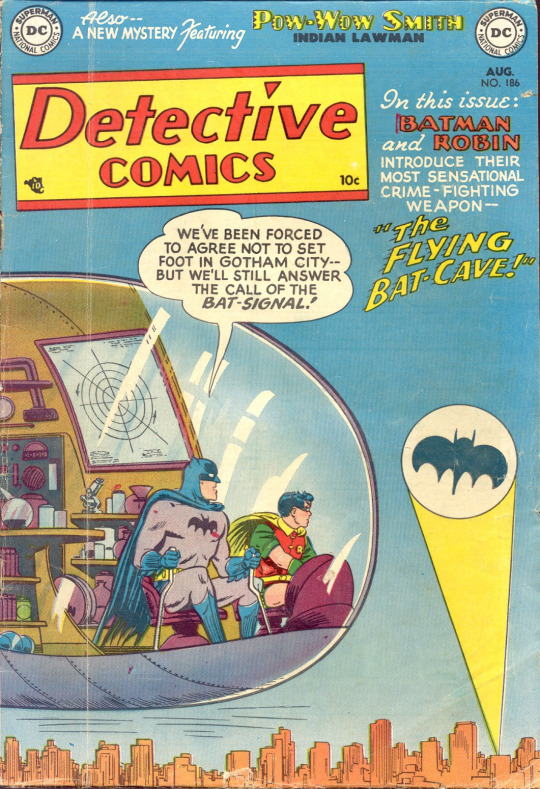
August 1952. One of the more remarkable things about Golden Age and Silver Age Batman stories is that the vast array of gadgetry Batman and Robin used was not originally created with merchandising in mind. There was some Bat-licensing in the 1940s and 1950s (you can see examples in Chip Kidd's 1996 book BATMAN COLLECTED — if you squint enough to decipher any of it through Kidd's pretentious production design), but it was not until after the debut of the 1966 TV show that the Bat-floodgates really opened — and it wasn't until much later that amazingly toyetic concepts like the Flying Batcave were translated into toys and collectibles.
The focus of the original Flying Batcave story is actually on the promise to which Batman alludes on the cover: At the beginning of the story, gangster Diamond Lang captures Robin and threatens to kill him unless Batman signs a written pledge that he "won't set foot in Gotham for a week." Batman responds by rolling out this enormous rotary-winged temporary headquarters (which is big enough that it actually carries some of the trophies from the Batcave, including the giant penny) and using an array of gadgets ranging from enormous cameras to powerful electromagnets to thwart crime in Gotham from the air. He even testifies against Lang in court via special closed-circuit TV link.
Why Batman goes to this much trouble is never very clear — it's not like Lang would have any legal recourse against him for breaking the agreement, which was made under duress, and Lang has, rather nonsensically, already fulfilled his end of the bargain by releasing Robin — but the crooks and the public take it as an article of faith that Batman would never break his word, however silly. Batman does, however, violate the spirit of the agreement pretty egregiously, including diving into the river in scuba gear to capture some thieves escaping through the drainage tunnels and finally parachuting onto the roof of a Post Office building, which he's quick to note is federal property and technically outside the bounds of Gotham City.
An "improved" Flying Batcave appeared in a story in DETECTIVE COMICS #317, 12 years later:

This time, there's no legalistic pretense for employing the flying headquarters; Batman and Robin take it out to visit a police convention in Center City and then use it to capture the intercity Condor Gang.
In 2016, Eaglemoss Collectibles produced a die-cast Flying Batcave as part of its "Special Batman Automobilia" collection. I've never seen one in the metal, but I kind of wish I had one.

(I feel like this should really have little figures of Batman and Robin at the controls, but this is perhaps nitpicking.)
#comics#detective comics#win mortimer#sheldon moldoff#batman#robin#robin the boy wonder#batcave#eaglemoss#you can tell i'm not a fan of chip kidd#i get what he's going for with his design aesthetic#i just hate it
37 notes
·
View notes
Text

Vintage Comic - Detective Comics #0230
Pencils: Win Mortimer
Inks: George Roussos
DC (Apr1956)
#Comics#DC Comics#Detective Comics#Batman#Robin#Mad Hatter#Vintage#Art#DC#CGC#Win Mortimer#George Roussos#Hats#Fashion#1956#1950s#50s
24 notes
·
View notes
Photo
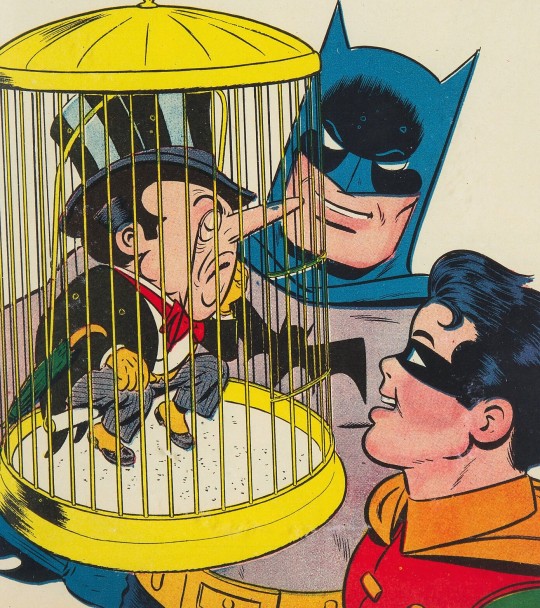
Fowl Play - art by Win Mortimer (1947)
226 notes
·
View notes
Photo

A 1953 cover for World’s Finest Comics (1941) #64. Art by Win Mortimer.
#im sorry im just so immensely charmed by this one its crazy. its adorable its evocative its stylistically fantastic#world's finest comics#world's finest comics 1941#win mortimer#bruce wayne#batman#dick grayson#robin#clark kent#superman#dc#dc comics#dcedit#comicedit#comicsedit#u can reblog
65 notes
·
View notes
Text
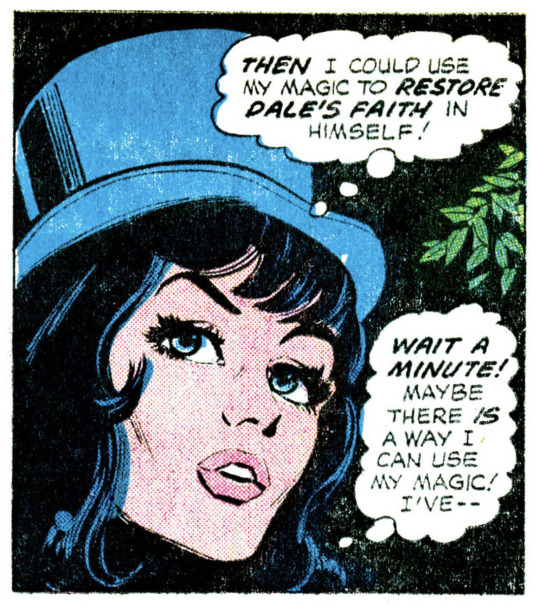
Wait a minute!
#adventure comics#zatanna#zatanna zatara#magic#wait a minute#steve skeates#win mortimer#dc comics#comics#70s comics#bronze age comics
56 notes
·
View notes
Photo

World’s Finest Volume 1, #41 (1949)
cover by Win Mortimer
#win mortimer#illustration#dc#dc comics#comics#batman#robin#superman#40s#vintage#retro#worlds finest
220 notes
·
View notes
Photo
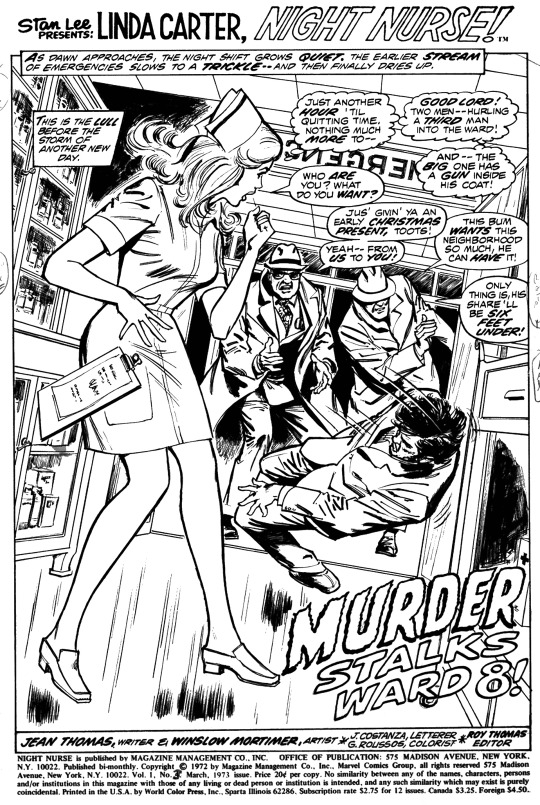
Night Nurse 3 pg1 by Win Mortimer
#splash page#title splash page#night nurse#linda carter#bronze age comics#Original Comic Art#win mortimer
49 notes
·
View notes
Text

Lois Lane in Superman Family #188 by Win Mortimer
45 notes
·
View notes
Text
BHOC: SUPERMAN FAMILY #193
I had skipped buying SUPERMAN FAMILY #192 the previous month, for reasons that I’m not quite certain of apart from just a general dissatisfaction with the title. That was the problem with DC’s Dollar Comics anthologies, they were wildly inconsistent. While any given issue probably had something in it that you thought was pretty great, it also tended to include something that you thought was…
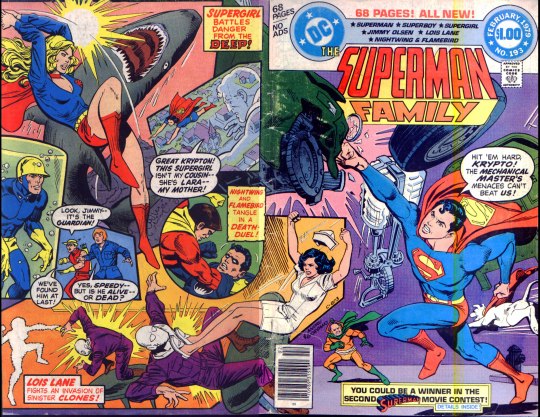
View On WordPress
#Arvell Jones#DC#E. Nelson Bridwell#Flamebird#Gerry Conway#Jimmy Olsen#Joe Staton#Ken Landgraf#Kurt Schaffenberger#Lois Lane#Nightwing#Paul Kupperberg#Scott Edelman#Superboy#Supergirl#Superman#Superman Family#Tom DeFalco#Win Mortimer
10 notes
·
View notes
Text

World of Metropolis #3 (1988) by John Byrne & Win Mortimer
8 notes
·
View notes
Text

August 18, 1946. In the comic books, the regeneration of Two-Face lasted for more than a decade, but in the syndicated Batman newspaper strip, Two-Face met a different and much grimmer end. This Sunday newspaper continuity was written by Bill Finger, who wrote Two-Face's early comic book appearances, and borrows parts of its plot from those stories (this scene is a variation of one from DETECTIVE COMICS #66), but the newspaper Two-Face is a vain actor, Harvey Apollo, not a district attorney; he has no fiancée; and he's presented as being unwilling to consider plastic surgery out of wounded vanity, rather than the only capable surgeon being in a Nazi concentration camp (as was initially the case in the comic book stories). Several of the continuities of the newspaper strip were similarly repurposed from early comic book stories.
This was one of the last Sunday continuities of the 1940s BATMAN newspaper strip, which ended in late 1946. Unlike Superman, who would remain a newspaper comics stalwart for many years, Batman and Robin's track record in the newspapers was hit and miss.
#comics#batman#newspaper comics#bill finger#jack burnley#win mortimer#golden age batman#two face#the combination of burnley and mortimer looks a little odd#mortimer said he ended up inking the strip because burnley had deadline problems#although elsewhere each ordinarily inked his own work
28 notes
·
View notes
Photo

(1954)
#Adventure Comics#Superboy#1954#comic book#win mortimer#cover#Superman#vintage#1950s#golden age#comics#DC#city#statue
68 notes
·
View notes